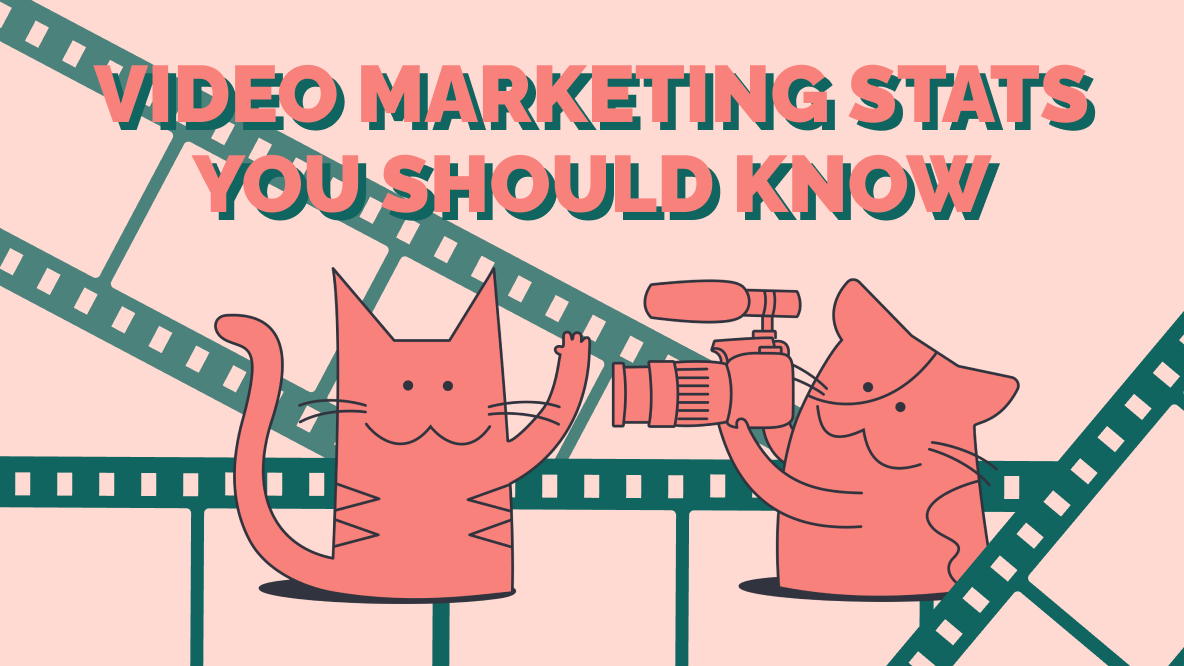Video Marketing Statistics You Need to Know in 2024
Video is a crucial part of any marketing strategy, and we’ve got the data to back that up.

Video marketing is at an all-time high, with 91% of businesses using video as a marketing tool in 2023, according to an annual report from Wyzowl.
Between TikTok, YouTube, Instagram, Twitch and other platforms, there are more places than ever for digital video to live. Video marketing can take many forms, from traditional video ads, to organic marketing on TikTok, to working with influencers or UGC creators. Not to mention there’s live video, webinars, and other types of informative video content.
There’s a reason nearly every platform has pivoted to prioritizing video. Every year, more and more video content is consumed by the masses. In 2020, 244.4 million people in the US alone watched digital videos. On a weekly basis, people consumed an average of 17 hours of online video per week in 2023.
As a marketer, it’s important not only to engage in video marketing, but to keep up with video and content marketing trends. In this piece, we’ll take a deep dive into all the video marketing statistics and data you need to know in 2024.
The rise of video marketing
Interestingly, online video consumption has actually slightly cooled off — but don’t take that to mean that it isn’t still huge.
Online video consumption reached an all-time high during the pandemic in 2022 at 19 hours per week, dropping to 17 hours per week in 2023. We can assume this has a lot to do with most people returning to normal work habits and getting back outside.
What’s important to note is that the trend is still towards growth. According to Wyzowl, back in 2018, people were consuming an average of just 10.5 hours of online video content per week. In 2019, it was 14 hours, and in 2020 it was 16 hours. So even though there was a slight dip for 2023, time spent watching online videos is still much higher than it was only five years ago.
All in all, a whopping 82% of global internet traffic came from video in 2022.
Also on the rise is demand for branded videos. In 2023, 91% of people said they want to see more online videos from brands — up from 88% in 2022, and 85% in 2021.
Video is also the most shareable type of content on the internet. According to Wyzowl, 51% of people are more likely to share a video with their friends compared to every other type of content marketing. For context, 26% are likely to share a social media post, and just 13% are likely to share a blog post.
All that means marketers have had to adapt and prioritize video in their strategies.
Video effectiveness and engagement
We know more people are watching videos, and more marketers are utilizing video in their strategies, but is video actually an effective engagement tool? According to the data, the answer is yes.
Video has proven to be a very effective marketing tool when promoting a product or service. According to Wyzowl, 96% of people have watched an explainer video to learn more about a product or service.
And more compellingly, 89% of people said watching a video convinced them to purchase a product or service. If you’re in the business of software and apps, 79% of people said a video convinced them to make that kind of purchase.
Video comes in many forms, but it’s short video that’s currently dominating. According to Sprout Social, 66% of consumers say short-form video — like what you’d find on TikTok, Instagram Reels, or YouTube Shorts — is the most engaging type of video on social media.
Interestingly, this short-form video is also a bit of an untapped opportunity. Wyzowl reports YouTube is the most widely-used video marketing platform, with 90% of marketers trusting it. That makes sense considering YouTube is the second-most popular website in the world. However, only 35% of marketers put their trust in TikTok, despite its massive popularity.
We can also talk about ROI — return on investment — for video marketing. According to Wyzowl, most markets — 63% — judge the ROI of their video efforts based on views, and 61% also look at audience engagement.
It’s also clear that marketers see video as a win, with 95% saying video has helped increase brand awareness. And 96% of video marketers say their efforts have increased user understanding of their product.
Additionally, 90% said video marketing generated leads, and 87% said video marketing helped increase sales. No matter how you look at it, video marketing is a win.
Mobile video consumption
You can’t talk about video consumption habits without also talking about mobile. Fact is, mobile is where most people are watching video.
Data shows about 90% of video is watched on a mobile device and the average person watches 25.7 minutes of video on their mobile device every day. According to Statistica, 63% of watch time on YouTube came from mobile devices in 2021, compared to just 12% on desktop.
The most-downloaded short-form video app is TikTok. That makes sense considering the short attention spans of mobile video consumers. According to HubSpot, the majority of people say the optimal length of a marketing video is under three minutes — and 16% say it’s actually under one minute. Short-form video platforms like TikTok, Instagram Reels, and YouTube Shorts are all vertically-oriented to be optimized for mobile consumption.
That’s why it’s vital that you’re optimizing your marketing videos for mobile. Keep them short, vertical, and consumable even if a phone is on mute. Interestingly, 75% of people watch mobile video on mute, and it’s higher for millennials at 85%. That means you should always add subtitles to video content.
This also presents an opportunity for mobile video ads. More people in the world own a smartphone with internet access than a desktop computer with internet access. That means mobile should really be your primary platform for video ads. Again, that calls for optimization. Only 30% of mobile users will bother turning their phone sideways to watch a video ad, so make sure to keep them vertical. Another reason to go vertical: Viewers will watch up to 90% of vertical ads, but only 14% of horizontal ones.
Social media video statistics
The majority of videos marketers are creating are for social media — 71% in fact.
The most popular destination is YouTube, with 90% of companies creating videos for the platform. Next is Facebook, at 86% of companies, then LinkedIn at 79%, Instagram also at 79%, Twitter at 54%, and TikTok at 35%.
According to Sprout Social, marketers also agree that video is the best thing to post on social media, with 54% saying it’s the most valuable for meeting social media goals. That’s followed by images at 53%. Live video also makes an appearance, with 25% of marketers using it.
Interestingly, video is still underutilized on social media platforms, with only 14% of Facebook content being video, although stats show it’s the content people love to consume most.
According to Meta, 91% of active Instagram users watch videos on Instagram every week and video is still the most engaging content type on the app. Videos, on average, receive more than double the comments of static image posts. And according to Statistica, even small accounts with up to 500 followers see a massive 892% reach with Instagram Reels, compared to only 77% for static images.
Over on TikTok, the app is dominating engagement for Gen Z.
In fact, more Gen Zers use TikTok than Instagram and 40% of TikTok users don’t even have a Facebook profile. Given that TikTok is purely mobile video, that says a lot about the importance of video marketing. The average TikTok user spends 95 minutes on the app each day. With more than a billion users, that’s a massive potential reach, yet so few marketers are tapping into it.
TikTok also has the highest engagement rate of any social media platform, at 4.25%, compared to just 0.6% for Instagram. Facebook is more in the middle at 0.15%.
No matter where you look, video is the most engaging type of content on every social media platform, and can’t be overlooked. When producing video for social media, you’ll get the best results with using a social media video editor.
Video and SEO
Search engine optimization inevitably plays a role in your marketing strategy, and video is a factor in that, too.
You should care about video for SEO because Google cares about it. As the world’s number one search engine, Google prioritizes placing relevant videos in search results. As the owner of YouTube, it makes sense that Google would do this, but it shows videos from other platforms, too. In fact, 70% of the top 100 search results listings contain video.
One of the factors Google takes into consideration when ranking results in its search results is the time spent on a page. Including videos boosts that time, thereby boosting your SEO ranking. Additionally, producing high quality video can earn you backlinks, another factor in Google’s algorithm.
Creating videos and sharing them widely can boost your click-through rate on search engine results pages, especially as Google is more and more keen to show videos in search results. That also means you need to be optimizing your videos for SEO.
Optimizing videos for search includes:
- Adding relevant keywords and hashtags to captions and descriptions
- Creating optimized thumbnails that are highly clickable
- Compressing large videos into mobile-friendly sizes
- Writing clickable video titles that include relevant keywords
- Including keywords in your video file name
- Utilizing tags effectively
- Including captions or subtitles, such as with an .SRT file, which can be made using a video editor
Explainer videos and product demos
Some of the most popular videos marketers create are explainers and product demonstrations. After social media videos, explainers are the most popular video type marketers create, with 70% making them. Additionally, 36% make product demonstration videos.
Education is what matters here. According to Wistia, 52% of companies create videos to educate their audience about their products. We know this is effective. As mentioned earlier, 89% of people said watching a video convinced them to purchase a product or service and 96% of consumers have watched an explainer video to learn more about a product or service.
The reason why explainer videos are so powerful is that people are inherently visual learners. In fact, viewers retain 95% of a message delivered via video, compared to only 10% for text.
Product demo videos are also crucial for any video marketing strategy. For consumers looking to make a purchase, 69% said a product demo video is the best assistant for making that decision. That’s compared to 15% for explainer videos, and 16% for customer testimonials. Especially when shopping online, product demos give customers the best insight into how a product actually works and will fit into their lives, even if they can’t touch or try it for themselves.
80% of people say product videos give them more confidence when making a purchase. Again, it’s all about being able to better understand how a product works before making the final purchase decision.
Add that all up and you have strong evidence that video — especially explainers and demos — are a powerful conversion tool. One retailer, StacksandStacks.com, reported that visitors were 144% more likely to make a purchase after seeing a product video, compared to those who didn’t.
Video in email marketing
Video can live almost anywhere on the internet, and that includes in emails. Videos are a powerful component of email marketing, and the stats back that up.
Just teasing that your email contains a video can boost your open rate. SuperOffice found that including the word “video” in a subject line boosts the open rate by a cool 6%. And, according to Campaign Monitor, including video in email marketing boosts open rates by 19%, click-through rates by 65%, and reduces unsubscribes by 26%.
Wordstream also reports that an initial email with a video receives an increased click-through rate of 96%.
The most straightforward way to include video in your email marketing is to embed video directly in your email sends. This can be as simple as embedding a YouTube link, or with a little more work you can host a video yourself to embed.
Segmentation and personalization have also proven to be important tools for conversion in email marketing. Take advantage of that by, for example, sending a product demonstration video via email to a customer who has just purchased your product for the first time. This is especially effective for SaaS brands looking to increase retention by supporting new customers through an onboarding process. Making videos demonstrating how to use your product and answering frequently asked questions by first-time users will help empower customers and alleviate any frustration or learning curve.
You can also use video in emails to entice customers to become repeat buyers. After an initial purchase, try sending an email with a video highlighting related or complementary products or announcing a new product.
Live video and webinars
Creating live videos and webinars is an excellent way to engage more directly with your audience and make interactive experiences.
You’ll actually be ahead of the curve if you create live videos — according to Wyzowl, only 36% of marketers have published live video content, such as livestreams on their social media channels. And it’s a missed opportunity.
Insider Intelligence reports that there are 163.4 live video viewers in the US in 2023. As well, 24% of US internet users ages 16 to 64 began watching live video during the pandemic. Although platforms like Twitch and YouTube seem most synonymous with live video, the most popular platform that creators use to go live is Instagram, at 62.1%. Facebook is next at 5.3%. Live videos are even stealing attention away from TV — 44% of people said they watch less live TV because of online streaming.
Live streaming accounts for 23% of video watched online — that’s big.
For marketers, the benefits of live video are a huge and eager audience, as well as the opportunity for real-time engagement.
Live video webinars are an especially effective tool for B2B brands. Consider that, according to BrightTALK, 62% of webinar attendees request a demo afterwards. As well, 54% of B2B professionals watch webinars on a weekly basis, according to Search Engine Journal. Webinars are also on the rise, with viewers watching three times more webinars in 2020 compared to 2019.
Finally, for e-commerce brands, live video is rapidly increasing in popularity as a marketing tool. It’s most popular in Asia on platforms like Duyin. In China, 77% of consumers have made a purchase from watching a live stream, as well as 75% of consumers in India, and 72% in Thailand.
It’s been slower, but live stream shopping iis making inroads in Western markets on platforms like TikTok, Poshmark, Facebook, and Amazon. The US livestream shopping market is estimated to be worth $68 billion by 2026 and account for 5% of e-commerce sales.
Video consumption behavior by demographics
Finally, we need to understand exactly who is eager to consume video marketing.
It should be noted that online video is popular across all age groups, but it’s especially watched by younger people. For Generation Alpha, 85% of children aged two to 12 say they watch YouTube. As well, about 15% of YouTube’s audience are ages 18 to 24 — about 377 million of them, according to HubSpot.
Gen Z also loves online video, making up 32% of the world’s population with 76% visiting YouTube at least weekly. As well, seven in ten teens spend more than three hours a day watching mobile videos.
All that means that if your target audience as a marketer skews younger, video is a must-have as part of your marketing strategy.
We also know that women are more likely to consume online videos. On YouTube in 2023, 51.4% of users in the US are female, compared to 48.6% being male.
Geographically, there are also some interesting patterns. The United Arab Emirates has the highest penetration rate for YouTube usage, at 98.5%, followed by the Netherlands at 92.6%, and Norway at 91.9%.
Going by pure volume, people in India watch the most online content per day, followed by the US, Brazil, Indonesia, and Mexico.
Win with video marketing
The numbers don’t lie — video is a must-have for marketers.
Online video consumption is higher than it's ever been and shows little signs of slowing down. We know that consumers make buying decisions based on video and that including video in your marketing, including marketing emails, is a proven conversion booster.
If you have to choose one place to create videos, social media reigns as the top destination for watching videos and can’t be overlooked.
What that tells you as a marketer is that platforms like YouTube, Instagram, TikTok, and Facebook are a prime destination for videos. In the future, expect to see a rise in live videos, particularly webinars and live shopping streams.
If you want engagement, conversions, and highly shareable content, look no further than online video for your marketing strategy.
Additional Resources
Create content faster with Kapwing's online video editor →








